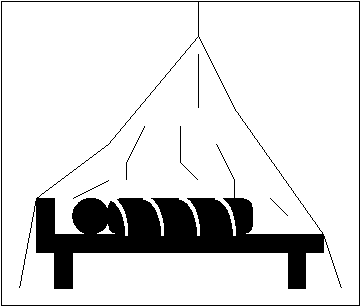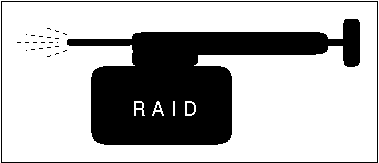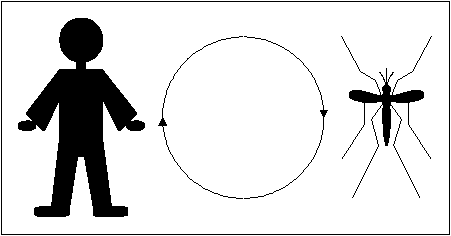
This lesson provides the teacher with material to teach the life cycle of malaria in a basic way. It may therefore be appropriate for primary school classes, or classes with slow understanding.
Topic
Instructional Objectives
Reference Books
Teaching and Learning
Aids to Be Used
- Materials
- Drawing of Life Cycle
- Text "Malaria Life Cycle"
- Text "Main Points"
Students Previous Knowledge
Presentation of
Lesson or Methodology
Remarks
- Background Information: Malaria
Parasite
- Background Information: Mosquito
Nets
- Background Information: Mosquito
Spray
- Background Information: Malaria Symptoms
- Background Information: Mosquito
Back to "Teaching Materials Malaria"
Malaria is one of the most important infectious diseases in the tropics, causing one to two million deaths a year worldwide. Unlike other infectious diseases as tuberculosis and AIDS, malaria can be cured easily, if treated in time. Teaching the life cycle of malaria is one way of rising awareness towards this disease and can, if properly understood, help to prevent unnecessary suffering among the affected population.
Back to orientation "Malaria for Primary"
1. Importance of the mosquito
2. Importance of preventive measures
3. Importance of prompt treatment
Back to orientation "Malaria for Primary"
WHO, 1996: "Malaria: A manual for community health workers"; World Health Organization, Geneva 1996
Back to orientation "Malaria for Primary"
The listed materials will ease the task of teaching. However, if some items should not be available, you can still teach the lesson.
Back to orientation "Malaria for Primary"
If possible organise a bed net, a mosquito spray (empty or full), and a mosquito repellent (coil or other).

Simple drawing of bed net (mosquito net).

Simple drawing of refill spray.
Back to orientation "Malaria for Primary"

Simple drawing of basic malaria life cycle.
This drawing can be replaced by any other showing a human being and a mosquito. It should either be copied on the blackboard before or during the lesson, or onto a poster-size paper. The latter one can be used several times, which may be convenient if many classes are taught on the subject.
Back to orientation "Malaria for Primary"
| Malaria Life Cycle
Malaria is caused by tiny parasites which enter and leave the body through mosquito bites. When a mosquito bites a person it sucks up blood. If the person has malaria, some of the parasites in the blood will be sucked into the mosquito. In the mosquito, the malaria parasites multiply and develop. After 10-14 days the parasites are mature and ready to be passed on to somebody else. If the mosquito now bites a healthy person, the malaria parasites will enter the body of the healthy person. After a week or longer the person will then become ill. |
This text has been adapted from WHO, 1996, p. 10-11.
Back to orientation "Malaria for Primary"
| What do I have to remember about malaria:
1. The malaria parasite needs the mosquito to spread from one human being to another. 2. Mosquito bites can be prevented by: Using a mosquito net; always closing the doors, spraying the rooms, and use of mosquito repellents. 3. Prompt Malaria treatment can save lifes. |
Back to orientation "Malaria for Primary"
Basic understanding of the English language.
Back to orientation "Malaria for Primary"
| Content/Breakdown | Teacher Activity | Student Activity | Time1 |
|---|---|---|---|
| a) Introduction | Introduce the topic with approach 1 "Malaria is dangerous disease", or approach 2 "Why do you think, so many people are suffering from malaria at this time of the year?". | Approach 1: Listen to the teacher.
Approach 2: Discussion. |
00' |
| b) Development of period | Malaria Life Cycle:
Draw or show the malaria life cycle on the blackboard or a poster. Tell the pupils how the malaria parasite jumps from man to mosquito and back. Write the text "Malaria Life Cycle" on the black board. |
Malaria Life Cycle:
Copy the drawing and the text "Malaria Life Cycle". |
05' |
| Importance of Mosquito and Prevention:
Point out that the mosquito is central for the outbreak of malaria. Show and explain the four main ways of avoiding mosquito bites: bed net, closed doors, spray, repellent. |
Importance of Mosquito and Prevention:
Listen to the teachers instructions. |
20' | |
| Treatment of Malaria:
Discuss the symptoms of malaria with the class. Stress the importance of quick treatment as malaria may make somebody very sick in a short time. |
Treatment of Malaria:
Describe own experience with malaria. |
30' | |
| c) Assignment | "Discuss with your parents, what they do to prevent mosquito bites in and around the house." | 35' | |
| d) Conclusion | Write "Main Points" on the black board. If you are short of time, you may repeat the three main points orally. | Copy "Main Points" from black board. | 40' |
1
1) Time differences between classes may occur. The time indicated is stated for a P5 or P6 class.Back to orientation "Malaria for Primary"
If the above mentioned materials, especially the bed net and the spray cannot be organized, still explain the use of the bed net and the spray to the children by using the drawings provided.
Background: Information
Malaria Parasite
Malaria parasites are small single-cell beings, which invade the red
blood cells in humans and animals. There are four different types infecting
humans of which so-called Plasmodium falciparum is not only the
most common but also the most dangerous as it can cause deathly attacks
of severe malaria. Unfortunately some strains of Plasmodium falciparum
are resistant against common drugs such as chloroquine. Whereas grown-ups
in endemic regions (places where malaria is common) normally develop some
resistance against the disease, this is not the case in small children
and pregnant women.
Back to orientation "Malaria for Primary"
Background Information: Mosquito
Nets
Mosquito nets have shown to reduce the prevalence of malaria in several
settings throughout Africa. Properly used, e.g. tacked under the bed, they
give protection from mosquito bites during sleeping hours. The WHO recommends
the use of insecticide-treated mosquito nets and calls them "a very good
way to protect people from getting malaria". Contrary to popular belief,
the new nets on sale do not block the circulation of air.
Back to orientation "Malaria for Primary"
Background Information:
Mosquito Spray
Indoor spraying is a method to reduce the prevalence of mosquitoes
in the house. If the doors are kept closed in the house, spraying may have
to take place once or twice a week. As many mosquito sprays contain powerful
chemicals, the instructions on the spray should be followed. In the long
run, a refillable spray may be cheaper than the disposable ones.
Back to orientation "Malaria for Primary"
Background Information: Malaria Symptoms
The most important feature of malaria are fever attacks which normally
start with shivering and end in profuse sweating. Headache and pains in
the back, joints or all over the body are common. Loss of appetite, vomiting
and diarrhoea may also occur. In between the attacks the patient may feel
better, but the repeated attacks will slowly weaken him or her more and
more. Especially young children can become very ill and die within a few
days, displaying convulsions or even loosing consciousness. In this case,
urgent treatment in a hospital is needed to save the child's life.
Back to orientation "Malaria for Primary"
Background Information: Mosquito
There are many kinds of mosquitoes. However, only a few species, all
of them belonging to the anopheline genius, are carriers (vectors) of the
malaria parasites. Anopheline mosquitoes have spotted wings and their body
displays an angle to the surface they are sitting on. Only the females
bite — the male only sucks plant sap. Female and male mosquitos can be
recognised by their antenna: Whereas the male mosquito has bushy antennas,
the female one has thinner looking ones. Malaria mosquitoes normally bite
during the evening hours, the night and in the early morning hours.
Back to orientation "Malaria for Primary"
Comments, suggestions or corrections, especially from Ghanaians, people from the teaching field or in malaria research to mattgig@freesurf.ch are most welcome.
Matthias Giger, August 1999 (Update: 30.01.2002)